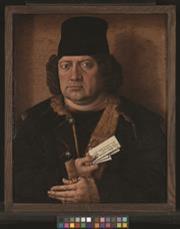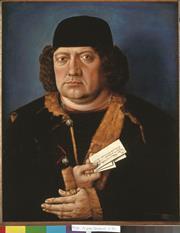As the RSC launches the Year of Chemistry and Art, Alex Kersting discovers how chemistry can reveal secrets hidden in works of art
2014 is the Royal Society of Chemistry’s Year of Chemistry and Art! You might well ask ‘why’? When you visit art galleries and museums, the science behind many of the artefacts on display is often lost. This year our mission is to provide ways to help uncover these hidden secrets. Using unusual examples and introducing you to new chemical techniques, you can explore not only the science behind national treasures, but also perhaps career paths linking art and science that you may not have thought possible. As the year progresses, you will be able to find all sorts of information about things to take part in on Learn Chemistry.
Painting behind the painting

To start the ball rolling, we have made a new set of Faces of Chemistry videos that feature two scientists from the National Gallery Scientific Department talking about the analysis techniques they use on a day-to-day basis. The videos take a close look at the Master of the Mornauer portrait and each video focuses on one particular technique used to discover the secrets hidden in the picture.

There are three videos, each exploring a technique aimed at a different age group and include:
- microscopy (11–14 years)
- scanning electron microscopy electron dispersive
- x-ray analysis (SEM-EDX) (14–16 years)
- chromatography (16–18 years)
Each of these techniques tells us something different about the paintings they analyse.
Paintings at the National Gallery are analysed with a variety of techniques when they arrive. When the Master of the Mornauer portrait was acquired it had a bright blue background. After analysing the painting, paint and binder, it was discovered that the blue background was not added by the original artist. In fact, the blue pigment was made from Prussian blue – a pigment not discovered until 300 years after the painting was originally painted! The background was painted blue later on in order to make the picture look like a Holbein painting. Holbein was very popular at the time and often painted blue backgrounds on his paintings – amazing!
More than just paintings
We have managed to sneak an art theme into just about everything we are doing this year and here are just some of the activities and connections we have in the pipeline. For example, in one major project, the RSC is working with the Victoria and Albert Museum to develop materials that explain the science behind many of the artefacts in their art and design collection.
Even the Bill Bryson Prize for 2014 has the theme ‘Where’s the Art in Science? Where’s the Science in Art?’
Conservation chemistry is also often closely linked to art and we are working with RAF Cosford to develop material about the conservation of the Dornier 17, a second world war German bomber that has recently been raised from the sea bed. The stories behind how the aeroplane survived for 70 years at the bottom of the sea are a fascinating mix of materials and electrochemistry.
Ionic magazine
In 2014 the RSC will connect chemistry with art, wherever and whenever possible! There is a special RSC edition of the Ionic Magazine (http://bit.ly/1kd8UEu) out now! This online magazine bridges the gap between science and art by publishing stories on recent developments across different sciences (linked to our collaborators), rewritten in a lay style with an artist’s representation alongside. There are no graphs, figures or formulae, just art constructed from personal interpretation. The January edition focuses on chemistry.
Join in and find out more
We are also linking the Chemistry and Art theme with the UN International Year of Crystallography by having a crystal growing themed global experiment.
More information will be available about this later in the year, and will tell you how you can take part. You will be able to upload images of the crystals you have grown and discover the link between the science and their beauty.
Our monthly public lecture series will be chemistry and art themed during summer 2014 with speakers from the National Gallery, Victoria and Albert Museum and the Wedgwood Museum. Look out for more information in the ChemNet newsletter.
A home for Chemistry and Art
As there will be so much activity and ways to keep in touch and learn more about chemistry and art, you will be able to find out everything you need to know in a new section of Learn Chemistry. This will show off all the links between the science involved with all of our partners. Anyone who is interested will be able to search the site by material, museum, chemical topic, colour … the list is almost endless! You can go through the site it to look at pigments used in paintings at the National Gallery, find a link to the paints and glazes used on Wedgwood pottery or even go on a search that might lead to finding out about ceramic artefacts from the Mary Rose.
This article was originally published in The Mole









No comments yet